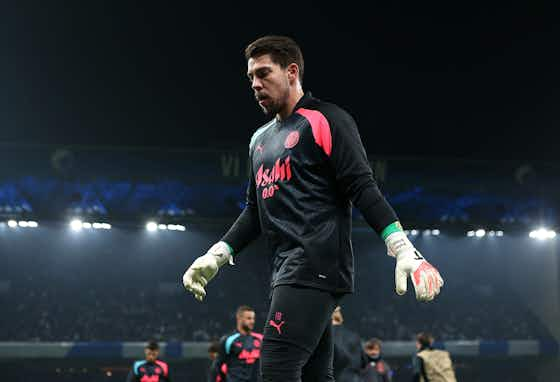EPL Index
·5 de agosto de 2025
Journalist: Man City plot exits with star trio yet to find new clubs

In partnership with
Yahoo sportsEPL Index
·5 de agosto de 2025

Manchester City’s decision to re-sign goalkeeper James Trafford for £27 million, just two years after selling him to Burnley for £14 million, offers a telling glimpse into the club’s evolving approach to player trading. The book value of the deal, effectively £13 million, reflects not a miscalculation, but a calculated reassessment of long-term squad development and internal value metrics.
City rate Trafford highly, and sources inside the Etihad believe he now returns more mature, more experienced, and significantly more marketable. Having starred at times for England’s Under-21 side and endured the harsh realities of a Premier League relegation battle, Trafford returns as a more complete asset.
This move may also reflect the slow winding down of Ederson’s time as undisputed number one. Though still elite, the Brazilian has not been without his inconsistencies. Trafford may not immediately challenge him, but this signing keeps City aligned with their wider ethos: control, succession, and self-reliance within the squad.
City’s recent history of buy-back clauses, performance-based sales, and player rotation across their affiliated clubs continues to be vindicated. They seldom spend unless the deal adds tangible value on and off the pitch. Trafford fits that mould perfectly.

Photo: IMAGO
The loan of 19-year-old winger Joel Ndala to Hull City underlines a shift in how City are choosing to develop their most promising academy talent. Ndala, once touted as a potential breakout star, now finds himself in the Championship after spells with PSV Jong and Nottingham Forest’s Premier League 2 squad.
That neither PSV nor Forest triggered their options to buy suggests Ndala is at a pivotal moment. While City have not cut him loose, the club is clearly recalibrating its expectations. His next steps will be decisive, both for himself and City’s long-term view on whether his ceiling lies within the Etihad walls or outside them.
Elsewhere, players like Claudio Echeverri and Vitor Reis could follow suit with loans, particularly with international ambitions hovering in the background. Echeverri’s camp believes he needs game time to earn a spot in Argentina’s World Cup squad. Girona, despite being a CFG club, is not viewed as the right destination, with the Premier League preferred if a loan happens.
For Reis, the preference seems to be the opposite. A loan to Girona could provide continuity and steady minutes, key for a young Brazilian defender still adapting to European football. This micro-managing of player pathways reveals a sophisticated model but one that walks a tightrope between control and stagnation.
Despite re-signing Trafford, City’s biggest task this summer might be subtraction. With less than a month to go in the transfer window, key questions remain over Jack Grealish, Kalvin Phillips and James McAtee.
Each represents a different kind of conundrum. Grealish is a marquee signing yet now feels peripheral. Phillips was brought in to anchor midfield rotations but has been largely absent. McAtee is viewed as a future starter but has not quite bridged the gap between potential and product.
The challenge is moving them on without undermining their value or squad harmony. Interest exists, but City, ever reluctant to sell below perceived value, are yet to commit. These situations are fluid, with the final week of the window likely to bring clarity.
City are also narrowing down their list of possible departures. John Stones, who some speculated might leave in the final year of his deal, will stay. So too will Abdukodir Khusanov, who is settling in after six months of cultural and tactical adaptation. His versatility, covering both centre-back and right-back, has impressed.

Photo IMAGO
City have not ruled out additional signings but are no longer actively seeking them. The Trafford deal marked the final proactive incoming move of the summer. Now, attention turns to managing the exit door.
There remains the possibility that a late-market opportunity may tempt City into action, particularly if a player becomes unexpectedly available in a position where depth is thin. But as it stands, the window’s shape reflects the club’s increasing reliance on internal promotion and strategic loans.
Players such as Sverre Nypan are attracting interest from Bundesliga clubs, while Max Alleyne is subject to a tug-of-war between Watford and Swansea City for a loan move. City want Alleyne to extend his deal first, a clear sign they see him as more than just a temporary asset.
These academy decisions matter. City’s ability to keep developing their own while trimming the first-team squad will define the tone for the 2025–26 campaign and beyond.
From a Manchester City supporter’s perspective, this has been a transfer window that speaks volumes without shouting. The return of James Trafford, for example, might not make headlines like a marquee striker or winger would, but it’s a reassuring nod to the club’s long-term planning. He is City DNA, built in their academy, and now returns stronger.
The fact the club hasn’t gone all out in the market reflects confidence in the existing squad. But there is also a sense among some fans that more creativity or firepower could be useful, especially if injuries bite. There is concern around Jack Grealish’s role. Has he fallen too far down the pecking order? And will the club get full value if he departs?
Kalvin Phillips and McAtee, while talented, need clarity. From a fan’s viewpoint, knowing who genuinely has a future at the club matters, particularly when watching the likes of Cole Palmer thrive elsewhere.
Still, it is difficult to argue with City’s model. Success continues to flow, the academy looks healthier than ever, and the player pathway, though sometimes winding, often leads to the right places. If Echeverri, Ndala or Alleyne can break through in the next 18 months, City supporters will see this quieter window as a masterstroke.






























































